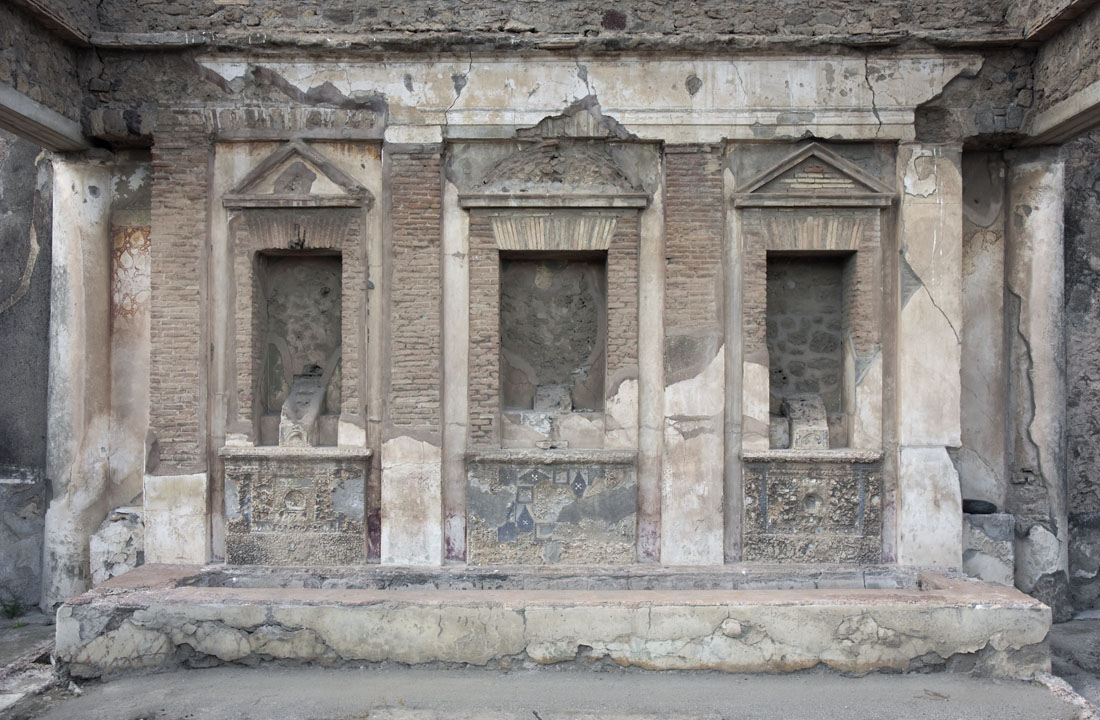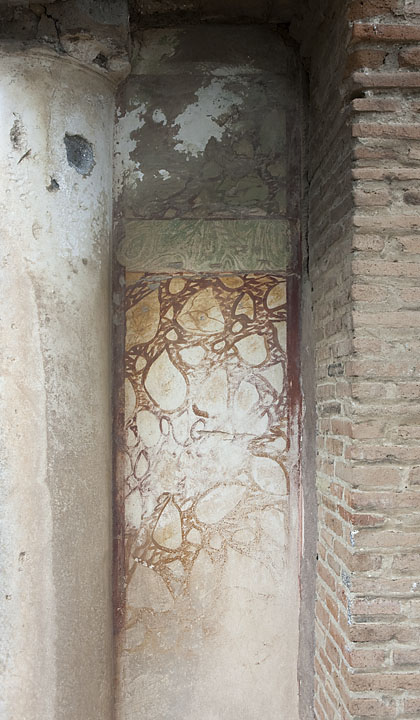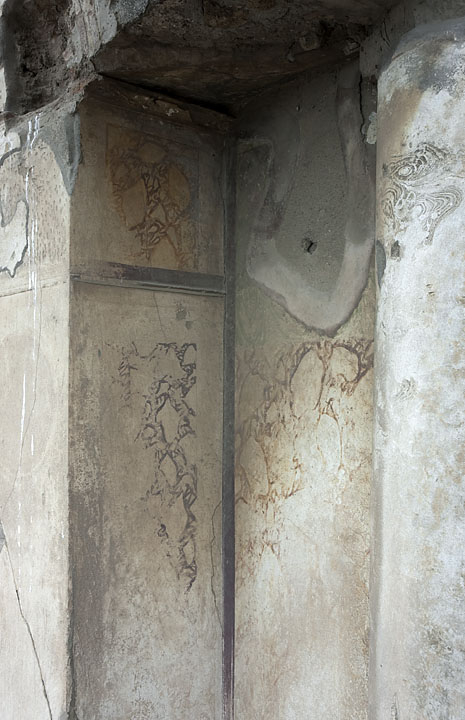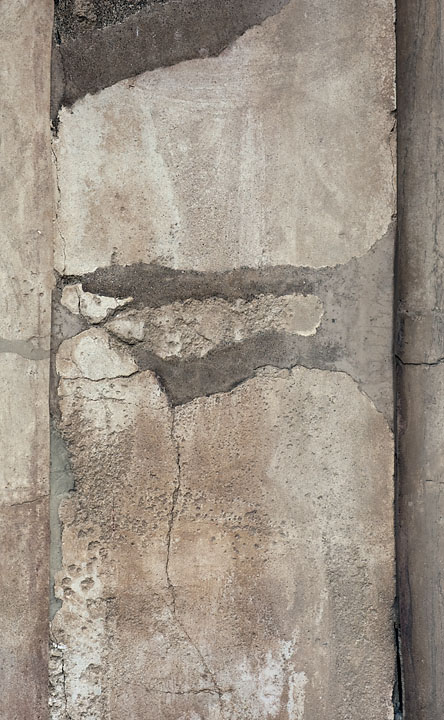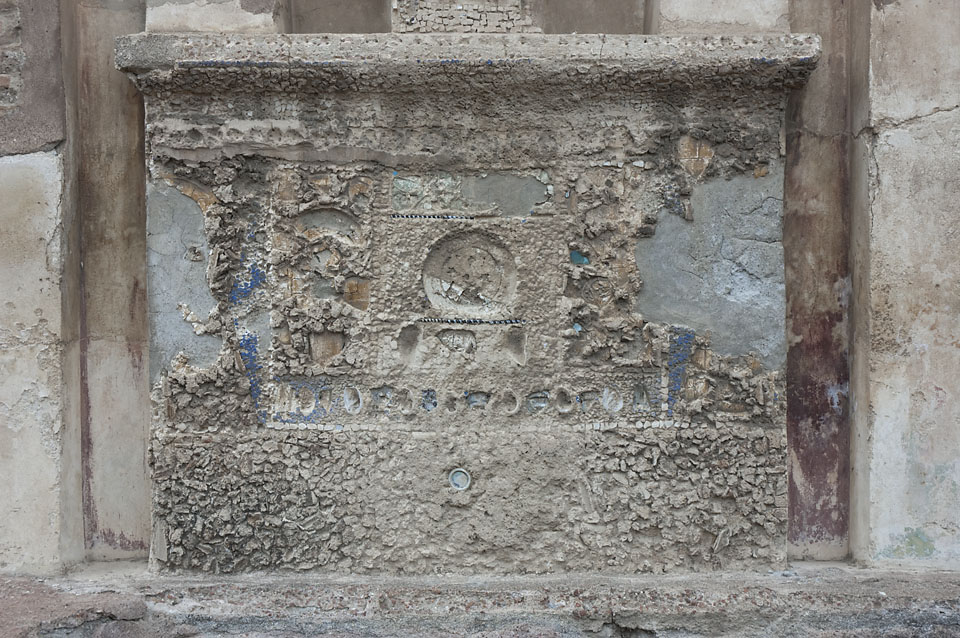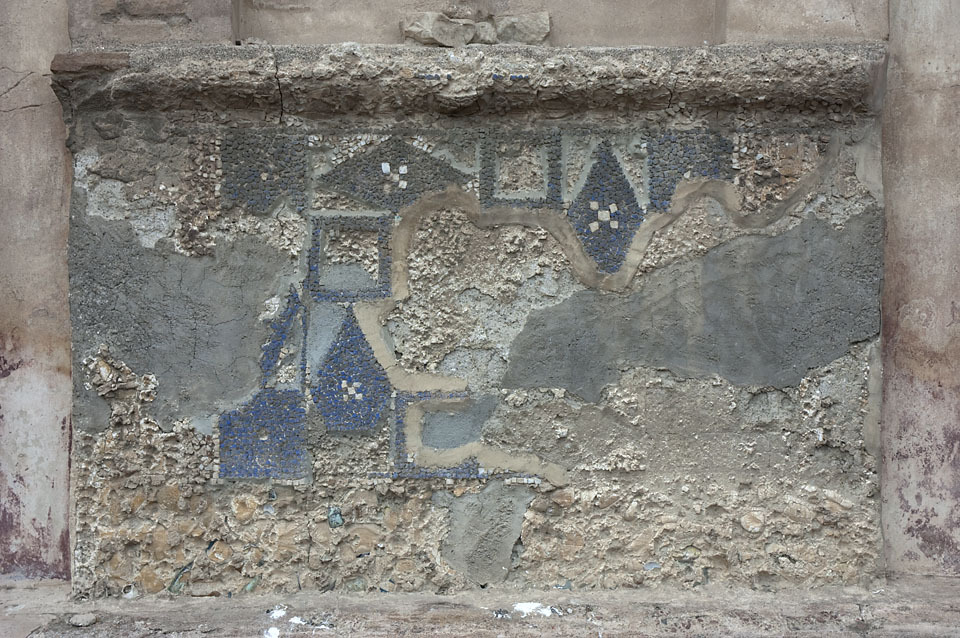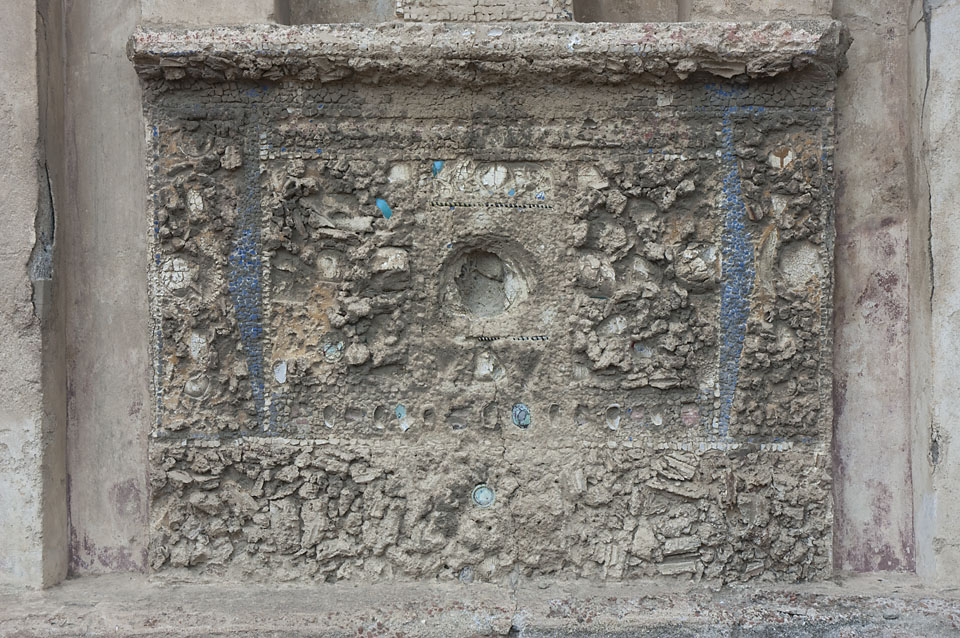Fountain 1
Description
Thomas Staub
The peristyle housed one of the most stunning fountain arrangements of Pompeii — the impressive façade nymphaeum placed along the north wall. It dominates the room with its rich architectural frame and its mosaic and fresco decorations. It was probably added to the house in the Augustan - Tiberian period as well as the fountains in the centre of the garden and in the south portico. These fountains were probably erected at the same time as the westernmost part of the peristyle area.
The nymphaeum consists of three niches with one water outlet in each, separated from each other by pilasters. Pediments crown the lateral niches, whereas the central one has an arch. Mosaics, using black and white marble tesserae, small pieces of Egyptian blue, pumice, shells, glass shards and twisted glass rods, adorn the front sides under the niches (see Sear 1977, 60-61). The frames of the niches and the wall areas in between are decorated with paintings imitating marble, the lateral pilasters with painted palm branches and shields and each of the two central pilasters with a depiction of a statue of a nymph, holding a shallow water basin in her arms (A watercolour by L. Mazzani, showing the nymphaeum in a slightly better state of conservation than today, was published by Maiuri 1929, 40).
In front of the nymphaeum an approx. 1.25-m-deep (upper rim ca. 0.51 m over the garden level) basin served as the receiver for the water from the fountains, both of the nymphaeum façade and from the 17 water jets along the upper side of its walls. The basin itself is divided into three parts by two roughly 0.6-m-high partitioning walls, each crowned by a small column or base whose original height cannot be established, since the uppermost parts are missing. The three sections were linked by lead pipes 0.08 - 0.1 m above the bottom. The outside of the basin walls was decorated with garden paintings framed by yellow trellises. The painted birds have been identified as those living in reed-beds and marshes (Identification made by A. Tammisto, see Andersson 1990, 230, n. 83). On the east side of the basin a lead pipe, continuing towards east along the north wall of room d and ending at the Posticum door V 1, 9, above the side street, served as an overflow outlet.
The dating of the large fountain has always created some problems, mainly because of the discrepancy between the relatively early design of the mosaics and the materials used for them compared with the painted decorations and the architectural layout of the fountain façade. In the earlier literature, the façade was usually ascribed to the Flavian period, because it was supposed that bricks came into use only after the earthquake of A.D. 62 (See Neuerburg, 1965, 121 and Sear 1977, 61). Also the motif of the alternating niche crowning, with pediments over the lateral niches and an arch over the central one has been used to date it somewhere in the latest period of Pompeii (See Hornbostel-Hüttner 1979, 82). However, since more recent research has proved that bricks were used even if sparely since Sullan times in Pompeii, the argument of the use of bricks have become obsolete (See Wallat 1993 on Opus testaceum in Pompeii). In addition, the dating of other facades with alternating crowning, most importantly the Eumachia building on the east side of the forum in Pompeii has been put back to Augustan or Tiberian times (See Wallat 1997, 270 — 272). The same is true for the building of the Castellum Aquae, which has also been used as a comparison for this fountain, even though the crowning of the shallow niches in the Castellum Aquae uniformly consists of arches. This building was earlier dated to the Flavian period as well, but is now placed in Augustan times (Ohlig 2001, 84).
The mosaics seem to belong to an early face of wall mosaics, mainly because of the use of relatively simple materials like shells, broken pieces of glass, pumice and Egyptian blue and especially the total lack of glass tesserae, which according to Sear were used from the beginning of the first century A.D. on (Sear 1977, 41). Finally, the wall paintings on the façade must be attributed to the Fourth Style (Anderson 1991, 230 — 232, tries to place them in the Third Style, arguing mainly that the Second Style is too early and the Fourth Style too late). It is possible that the mosaics belong to the original phase of the fountain, whereas the paintings were executed after a repair or rebuilding. On the west side of the basin in front of the façade there is a pipe which lacks any functional relation to the other pipes in this area as well as a connection to the distribution box. This pipe probably belongs to an older water circuit that was taken out of use when the rather numerous new pipes to be found in this area were installed. A further pipe belonging to an older system can be seen continuing into the low pedestal to the west of the nymphaeum. Both pipe and pedestal may be remains of an older fountain that later went out of use (It is this pipe that had earlier wrongly been interpreted as the supply pipe for the house, cf. Anderson 1991, 224. The supply pipe for the house was found in the west, underneath house V 1,28). Thus it seems probable that the water system of the nymphaeum was changed or reworked at some time in its history, probably involving some alterations of the façade itself. This could indicate that the mosaic panels still belong to the first phase of the fountain, whereas at least the paintings on the façade were made after some repair and remodelling of the fountains.
Thus, judging by these mosaics and the architectural design of the nymphaeum, it seems plausible to say that the fountain wall was erected in the Augustan-Tiberian period or slightly later and then in a second stage restructured and redecorated with paintings of the Fourth Style. An examination of the faint remains of the painted imitation of marble indicates that the decoration here seems to belong to quite a late phase: The rendering is reminiscent of the painted marble in the Casa della Caccia Antica (VII 4,48), where the Fourth-Style decorations have been attributed to the time of Vespasian (See Allison and Sear, 2002, 83f).
A further important clue for the dating of the nymphaeum can be found by studying the water connections for the fountains on the one hand and for the baths and kitchen area on the other hand. In kitchen l, a water distribution system including two distribution boxes connected with each other and several pipes was discovered. The pipes are leading both towards the atrium of V 1,3, the kitchen itself, and towards the large distribution box in the garden. Since the water arrangements were made in one operation, the fountains must be contemporary with the baths. Thus, the nymphaeum could be dated to the Tiberian or slightly later period.
Nymphaeum — details
Width (between the two half columns at north wall): 7.73 m, max. preserved height 4.90 m, above 4.35 m height as a modern reconstruction.
The section between the western half column and the facade of the nymphaeum is 0.50 m wide and is, in 4.00 m height, crowned by the architrave reaching over the entire nymphaeum, protruding ca. 0.12 m, 0.35 m high, thus creating the impression of a niche between the half column and the facade. This niche is completely covered by plaster, with remains of the decorations in the upper parts. The lower part of the cornice, the roof of the niche, is constructed of standing, slightly diagonally arranged blocks of Sarno stone and cruma (0.10 - 0.15 x 0.20 m), and above this part in opus incertum of lava, Sarno stone and tuff, between fist large and 0.15 x 0.10 m in size, set into a yellowish mortar. In the lower part of this section, a pedestal is set against the wall, 0.05 m to the east of the half column, height 0.90 m, width 0.45 m, and d: 0.41 m, mostly covered by plaster. Where the building material is visible, it consists mainly of a yellowish concrete with large pieces of lava, brick, Sarno stone and plaster spolias. 0.10 m above the ground, 0.33 m from western edge, a lead pipe leads into the pedestal. This pipe probably belongs to an earlier phase of the nymphaeum, since no corresponding fountain or traces thereof can be observed. On the upper side of the pediment, a rectangular (0.20 x 0.18 m) area is covered by modern concrete. The south-western upper corner of the pediment is damaged, and the layers of fine plaster and under plaster (0.021 m thick) are visible, and a further thin grey layer of smooth and homogenous structure (ca. 0.004 m thick) is placed underneath the plaster.
From here on (until the description of the eastern niche), all heights are given in relationship to the upper edge of the basin, 0.50 m above ground level.
To the east of the described section, a 0.50 m wide pilaster is protruding for 0.49 m. Since the stucco capital is missing, it is not possible to determine the exact height. It protrudes to the same level as the architrave over the entire part of the north wall between the two half columns. The pilaster is built of tiles, 0.03 - 0.035 m thick, except for one layer in 1.35 m height, which consists of 0.06 m thick bricks. The lowest row of the cornice is constructed of diagonal standing tuff-blocks and double rows of bricks, above this with the same opus incertum as in the westernmost part. The western side is covered with plaster up to a height of 1.10 m, the front up until 0.60 m and the eastern side in its entire height, partly with modern repairs. Of the decorations, only faint remains of the colours (green at the bottom, else yellow) are visible.
To the east of that pilaster follows a 0.10 m deep niche, width 1.43 m and height 3.55 m, which is entirely covered by plaster, with a few remains of the decorations. In the centre of this niche, the westernmost aedicula with a pediment is placed on top of a 0.98 m high pedestal decorated with mosaics. The upper 0.06 m of the pedestal protrudes for about 0.03 - 0.05 m. The rectangular aedicula is 1.16 m wide and 1.95 m high. A profiled fries, protruding for 0.05 - 0.08 m, frames the 0.55 m high pediment, the two upper sides still covered by stucco, the base only preserved in its core made of bricks. The top of it reaches against the architrave. In the centre of the aedicula, on top of the mosaic pedestal, a niche for the fountain is installed, 1.60 m high, width 0.70 m and d: 0.44 m. Parts of the niche are still covered by plaster, where it is missing, the sides are constructed of bricks, whereas the rear wall is made up of a modern restored Sarno stone incertum. Some remains of colour are still visible (at the rear wall, green at the bottom and blue at the top, on the sides remains of yellow faint marble) and on the upper western side, a stuccoed capital in the form of a Lotus-flower (height ca. 0.15 m) is preserved. In the centre of the niche, a cascade was placed (height 0.57 m, width 0.28 m), flanked by two pedestals, 0.24 - 0.25 m high and 0.20 m deep. The front (0.28 x 0.19 m) of the cascade is decorated with a simple mosaic, framed by one row of white, irregular tesserae, followed at the bottom by three rows of pieces of black marble, and at the sides 0.025 m wide stripes with Egyptian blue. The centre was decorated with a semi-circular glass plate of which only the imprint remains, framed by white tesserae, surrounded by Egyptian blue. Twisted glass rods (0.008 m large), of which also only the imprints remain, framed the sides of this field.
A 0.50 m wide and 3.50 m high pilaster, once more constructed of bricks, separates this western section of the wall from the central niche. The pilaster is covered with plaster on its flanks over the complete height and on the front, up to 1.15 m, with only slight traces of colours (green and red) at the bottom. The top of the pilaster shows two layers of protruding (0.02 and 0.04 m) bricks, probably the core of a now lost stuccoed capital. The next following niche is 1.80 m wide, 3.55 m high and 0.10 m deep, and around the inserted aedicula completely covered by plaster. The centrally placed aedicula (width 1.40 m, height 1.95 m) stands once more on a pedestal with a projection at its top (height 0.06 m, d: 0.05 m) and is adorned with mosaics. A max. 0.45 m high arch, in parts modern reconstructed, crowns this aedicula. A profiled frieze probably framed even the arch, where only the bricks of the base are reconstructed. The semi-circular field in the arch is built with rectangular blocks (0.08 x 0.08 m) of lava, cruma and Sarno stone, the aedicula is constructed of bricks, the top partly modern reconstructed. The niche of the aedicula is 0.90 m wide, 1.60 m high and 0.44 m deep. At the bottom, a 0.35 m high and 0.33 m deep step goes over the entire width of the niche. In the middle of it, remains of a ca. 0.20 m high, 0.32 m wide and 0.26 m deep pedestal, with small remains of a 0.26 m wide and 0.045 m high marble plates are visible. The original form of the marble plate is no longer reconstruct able, since it is too damaged. In the centre of it rear part, a round hole was drilled into it; next to this some metal imprints are preserved. The rear wall is only partly covered with plaster (some blue colour fragments preserved in its upper part), and where the building material is visible; it consists of opus incertum of mainly Sarno stone pieces in reddish mortar.
A 0.50 m wide and 3.50 m high pilaster, once more constructed of bricks, separates this central part of the wall from the eastern niche in the wall. The pilaster is covered with plaster at its eastern side up to 3.00 m height (without any remains of the decorations) and at its front up to 1.90 m, with slight traces of the paintings. To the east of that pilaster follows once again a 0.10 m deep niche, width 1.43 m and height 3.55 m, which is entirely covered by plaster with few remains of the decorations. In the centre of this niche, the easternmost aedicula with a pediment is placed on top of a 0.98 m high pedestal decorated with mosaics. The upper 0.06 m of the pedestal protrudes for about 0.04 - 0.06 m. The rectangular aedicula is 1.15 m wide and 1.95 m high. The 0.55 m high pediment is in a modern reconstruction framed by a profiled frieze, protruding for 0.05 - 0.08 m. The front side of the aedicula is covered with plaster up to 0.70 m height. Like in the western aedicula, a cascade is found in the centre of this aedicula (width 0.30 m, height not measurable because of damages), with a part of a lead pipe visible at 0.28 m height. Two small pedestals (height 0.25 - 0.28 m) again frame this cascade. The front of the cascade is once more decorated with a small mosaic using white marble tesserae, pieces of Egyptian blue, twisted glass rods and a semi-circular glass plate (of which only the offprint is visible). In the niche, only the bottom 0.20 m is still covered by plaster, showing faint traces of green colour. The visible parts of the rear wall seem to be a modern repair of Sarno stone blocks (fist large - 0.20 x 0.20 m in size) in modern concrete. The inner sides of the aedicula are covered with plaster until 1.90 m height, showing remains of the course marble imitation (red veins on a bright ground) as observed earlier on the nymphaeum.
The eastern framing pilaster (measurements as before) is nearly completely covered by plaster but without any traces of colours. In 2.45 m height, the imprint of a painted tondo (diam. 0.37 m, with a 0.03 m wide frame) is visible. In 2.95 m height, a thin (0.005 m) horizontal line is stuccoed on the plaster, above this, in parts, remains of a thin stucco layer are preserved for 0.45 m. Where this has fallen off, the pecking in the plaster for a better attachment of the stucco are discernible. Between the pilaster and the architrave, one row of bricks is protruding slightly, probably the remains of a stuccoed capital. Above this, there is 0.30 x 0.25 m large, 0.08 m deep hole in the architrave. The building material to the east of it consists, at the bottom of the architrave, of diagonal standing tiles and Sarno stone blocks, and above, of small Sarno stone and lava-blocks. Even the eastern side of the pilaster is largely covered by plaster, above 2.20 m height with some remains of the decorations. Up to 2.80 m height, it consists of an imitation of red-veined marble, framed on the sides by a 0.09 m wide stripe, on the top by a 0.15 m wide stripe, whose colour is no longer discernible. Above the upper frame follows a thin stuccoed line (as on the front side), followed by a dark red 0.05 m high stripe. Above this, a field (height 0.40 m) of a yellowish marble-imitation is framed by a 0.09 m wide stripe of unknown colour, toped once more by a dark red 0.06 m high stripe. The connection to the lower side of the architrave is created through a ca. 0.05 m high concave stuccoed profile.
The following part of the wall, between the easternmost pilaster and the eastern half-column, is 0.55 m wide and is largely covered by plaster. Between 2.60 m and 3.20 m height, (above peristyle floor) parts of the painted marble imitation (red veins on yellow ground) are preserved, as well as the uppermost parts of the decorations, corresponding with the decorations in the western niche. Even at the bottom of this niche, a 0.90 m high, 0.50 m wide and 0.42 m deep pedestal is put against the rear wall, covered with plaster and with a red marble imitation on its eastern side, separated from the half column by a 0.05 m wide dark red painted stripe. On the upper side of this pedestal, a modern repair once again covers the central part (0.22 x 0.17 m). At the bottom of the pedestal, an enforcement of the wall protrudes between 0.07 and 0.24 m, up until a height of 0.33 m, mainly constructed of brick and ceramic shards. This served probably as a protection for the lead pipe, transporting the superfluous water from the basin out to the back street.
The mosaics on the pedestals
The mosaic panels decorating the three pedestals are partly damaged and heavily incrusted with the sinter layers, the result of the flowing water from the three fountains above.
The western mosaic:
The western panel measures 1.15 m across and has a height of 0.96 m. It is capped by a 0.055 m high cornice, protruding for 0.03 - 0.05 m, decorated probably at the top with one row of irregular white marble pieces (only one is preserved, 0.013 x 0.007 m), set into red stucco, and at the bottom with one row of Egyptian blue. The convex zone underneath shows at the top a 0.042 m high zone with pumice, underneath a zone (height 0.042 m) with mixed white tesserae and Egyptian blue. The upper part of the panel itself shows imprints of shells in a 0.05 m high row, at the western side reaching to the end of the panel, at the eastern side stopping 0.20 m from the corner, where a standing, rectangular field with pumice and imprints of glass shards on yellow plaster ground is found. On the western side, a similar field is found underneath the row with shell imprints. These fields are largely damaged and repaired in modern times. The central part of the panel shows a rectangular zone, 0.71 x 0.48 m, framed on all sides by one row of irregular white tesserae. On both sides, elongated triangles (height 0.47 m, max. width 0.07 m) with pieces of Egyptian blue are attached, protruding into the fields with pumice on yellow ground. The bottom part of this central part consists of a row of alternating shells and glass shards pressed into a 0.085 m high stripe with Egyptian blue. Of these elements, only a few fragments are preserved, but one can by means of the imprints see that there were eight pieces of glass and seven shells. The glass shards (0.02 x 0.04 - 0.04 x 0.04 m) come from different types of glass vessels, at least four of them are made in mille-fiore technique with blue, violet, white and green glass, some were probably coloured, at least one of them red. Above the stripe, a horizontally three-parted middle field is flanked on both sides by standing rectangles, 0.17 - 0.18 x 0.36 - 0.37 m, separated by double rows of white marble pieces. They have a yellow ground, partly covered by pumice and with inserted glass shards. The remaining fragments of the shards, once more, show different colours: red, darker and brighter blue. The area in between (0.29 x 0.36 m) is divided into three parts. The uppermost is a 0.29 x 0.09 m large rectangular with green plaster into which, once more, glass shards were pressed (no fragments of these are visible, only the imprints in the plaster), at the bottom one can observe one row of Egyptian blue. Underneath this follows a zone (0.29 x 0.18 m) covered with Egyptian blue, separated from the upper and lower zone by twisted glass rods (0.008 m large, the top one black and white, at the bottom two different ones beside each other, black and white with yellow, and to the right, black and white with turquoise). In the centre, the imprint of a round glass plate, diam. 0.17 m, is visible (no remains preserved). A rectangular field (0.29 x 0.09 m) with pieces of white marble, and the imprints of two shells, as well as one, probably blue, glass shard, makes up the lowest zone of the central part. The lower part of the panel (height 0.26 m) is decorated with pumice, and in the middle there is one round glass shard (diam. 0.039 m), probably red, but now with a greenish surface.
The central mosaic
The central panel measures 1.40 m across and has a height of 0.91 m. It is capped by a 0.055 m high cornice, protruding for 0.03 - 0.05 m, probably decorated with shells pressed into the yellow coloured ground, and at the bottom pieces of Egyptian blue. The convex zone below (dimensions as at the western pedestal) shows the imprints mainly of glass shards (a fragment of one is preserved, which shows a piece of a multi-coloured glass object with yellow, opaque white and blue) and shells, surrounded by white tesserae, and with one row of Egyptian blue separating it from the panel itself. At the same time, this line constitutes the upper border of the central field, which, on the sides and the bottom, is framed by one row of white tesserae. The central part (0.90 x 0.61 m) consists mainly of squares and lozenges made of Egyptian blue. Its sides consist of a standing rectangle on each side (the one on the eastern side is very damaged but can probably be reconstructed as a reflection of the western one), composed of three parts each: at the top and the bottom there is a square field (0.14 x 0.14 - 0.15 x 0.15 m) of Egyptian blue with one white tessera in its centre, and in between, there is a rectangle (0.29 x 0.13 m) with white tesserae with a standing lozenge inscribed in it. Whether these lozenges also had a central ornament is not known, since they are too damaged.
Inside these two standing rectangles, a square forms the middle of the panel. It shows a diagonally symmetrical composition, where the elements in the corners are reflected in the opposite corner, i.e. the lozenge in the upper left corner is repeated in the lower right corner. Even if parts of it are destroyed, a reconstruction of the composition is possible. To the right of the rhombus (ca. 0.28 x 0.14 m), with an inscribed four pedalled flower composed of five white tesserae, is a square (0.14 x 0.14 m) in Egyptian blue with an inscribed smaller square (ca. 0.08 x 0.08 m), made of white tesserae. After that follows, in the upper right corner, a standing rhombus with the same dimensions and measurements as the one before, underneath it, a square as the one before, then in lower right corner, a laying rhombus, then another square, then in the lower left corner, another standing rhombus, followed by the last square, on the right side, underneath the first rhombus. Since the square inside these ornaments is missing today, we do not know how that was decorated. This central part was, on the sides, framed by 0.05 m wide vertical stripes with white tesserae and smaller pieces of pumice. The outer part of the panel was ornamented with a yellow ground into which pumice and glass shards were pressed (of the shards only the imprints are visible today), whereas the lower part also shows imprints from shells and some remains of the glass shards, e.g. one piece from the bottom of a vessel and another from an upper rim.
The eastern mosaic
The composition of this panel corresponds to the western one, but is slightly better preserved; the dimensions are 1.14 x 0.93 m. It is once more capped by a 0.055 m high cornice, protruding for 0.03 - 0.05 m, decorated at the top with one row of irregular white marble pieces set into red stucco, and at the bottom with one row of Egyptian blue. In the centre underneath is one stripe, 0.76 x 0.08 m, framed by white tesserae, with imprints of shells on a red ground, underneath a 0.025 m high zone with pumice and, finally, one row of Egyptian blue. This stripe is repeated under the central part of the panel, but with alternating shells and glass shards (once more eight imprints from glass, without any remains, and seven from shells), surrounded by Egyptian blue (0.75 x 0.11 m). The central part is composed as its counterpart in the western aedicula, with the same tripartition and flanking by elongated triangles. The glass plate in the centre was slightly smaller (diam. 0.15 m), and the twisted glass rod framing it shows a bit different colours: the upper ones are black and yellow and black, yellow and white, the lower one black, yellow and white. Also the lower and the side parts of the panel show the same decorations with pumice, and in the bottom part one small round glass disk (diam. 0.04 m) as the western one, only a shell has been added in the lower part. Here two parts of lead pipes are visible in the middle, 0.06 m from each other.
Also the front of the cascade in the niche above shows the same composition as its western counterpart, but here only the imprints of the twisted glass rode are visible.
Basin in front of the nymphaeum
Dimensions (interior): l: 5.58 m, width 0.92 m, d: 1.25 m; of the enclosure walls: west wall: l: 1.53 m, width 0.64 m, height (above garden level): 0.51 m; south wall: l: 6.67 m, width 0.48 m, height 0.56 m; east wall: l: 1.56 m, width 0.45 m, height 0.56 m. The basin is divided into three compartments by two lower walls inside the basin, ca. 0.67 - 0.70 m high above basin floor, 0.34 - 0.36 m wide, both crowned by remains of small columns, the western one preserved until 0.26 m high, diam. 0.29 m, the eastern one until 0.35 m high, diam. 0.31 m. The western section is 1.38 m long, the central one 1.98 m, and the eastern one 1.51 m, thus more or less taking up the difference in the dimensions between the central aedicula compared with the lateral ones. The corners at the bottom of the basin are sloping. Since the hydraulic plaster on top of the west dividing wall is missing, one can observe the construction materials, which consists of a mixed opus incertum of Sarno stone, lava and pieces of brick in a yellowish-greyish mortar. At the wall, underneath the western mosaic panel, two layers of plaster can be observed: a first, being a normal under plaster (containing lava and other fine split in lime), covered by the second one, a reddish hydraulic plaster.
Near the bottom (0.04 m above the floor), in the middle of the western side of the basin, a lead pipe goes through the wall towards west (diam. 0.036 - 0.047 m), probably serving for the emptying of the basin and/or for cleaning or changing of water. In front of this, a rectangular marking in the basin floor (0.20 x 0.11 m) could be remains of a closing arrangement for this pipe. The drainage for the superfluous running water is placed on the east wall, ca. 0.05 m beneath the upper rim of the basin (diam. 0.033 - 0.048 m), continuing towards the east and emptying out to the Vicolo di Caecilius Iucundus. In the small dividing walls at 0.18 - 0.20 m height, lead pipes are connecting the three compartments (diam. 0.038 - 0.049 m), ensuring a certain water exchange to take place. Above these lead pipes, an older connecting system was closed in antiquity (as is shown by the sinter layers covering the closings), probably when the lead pipes were put in. This older system consisted of two openings in each wall, at a height of 0.37 - 0.38 m and with a diam. of 0.10 - 0.11 m, clearly larger than the later one using the lead pipes. A further remain from an earlier phase might consist of a shallow semi-circular groove (ca. width 0.02 m) running from the inner side at north-east corner to the outside, partly covered by a later plaster, which might have served as the earlier overflow channel. (The area around the lead pipe is covered by modern plaster, so that no traces of a secondary instalment of this are visible.) On the inner side of the three outer walls, an irregular joint is visible under the top of the basin (between 0.05 - 0.25 m under the upper side of the walls), dividing the hydraulic plaster covering the walls from the one covering the upper side. Since the upper plaster shows no remains of sinter, not even at its lowest points, where the surrounding wall plaster clearly does so, it is probably a modern repair.
In the middle of the upper side of the basin walls, a lead pipe is running around, best visible at the east wall, where both the modern and the antique plaster are missing. The area next to the pipe (ca. 0.05 m on each side) is made up of a yellowish mortar, into which larger ceramic shards (up to 0.05 x 0.03 m) are pressed, whereas the parts further away consist of a whitish (rich on lime) hydraulic plaster with smaller ceramic shards (0.015 x 0.01 m). This pipe supplied the small sprouting fountains on the upper side of the parapet walls, which are partly covered by the modern plaster. On the west wall, two of these fountains are visible, 0.19 m from the inner side at 0.355 m height, and 0.84 m from the eastern pilaster of the nymphaeum. Along the south wall, the fountains are placed more in the middle of the wall, 0.22 m from the inner rim and 0.24 m from the outer one. Nine fountain-mouths are visible, starting at 0.65 m from the outer west corner; probably further four are hidden underneath the plaster:
1. Visible 0.65 m from corner
2. Visible 0.45 m to the east
3. Hypothetic 0.44 m to the east
4. Visible 0.44 m to the east
5. Visible 0.47 m to the east
6. Hypothetic 0.46 m to the east
7. Visible 0.46 m to the east
8. Visible 0.47 m to the east
9. Hypothetic 0.46 m to the east
10. Visible 0.46 m to the east
11. Hypothetic 0.47 m to the east
12. Visible 0.47 m to the east
13. Visible 0.47 m to the east
In this reconstruction, the fountains would have been placed with a more or less regular distance between each other. On the east wall, finally two more are visible, at 0.33 m and 0.80 m from the eastern pilaster of the nymphaeum, again more or less in the middle of the wall.
On the outsides of the two lateral walls, the decorations are not preserved, even if a few traces of colour (yellow, green and black) indicate, that they were decorated. On both sides, the cocciopesto covering from the gutters abuts against the plaster of the wall.
On the front side, some remains are still visible, showing that it was decorated by a garden painting. Description, from west to east: in the westernmost part, a ca. 0.80 m wide area shows remains of a painted trellis with yellow-ochre coloured, and 0.02 m wide, oblique sticks crossing each other, thus forming 0.07 x 0.13 m large lozenges, on a dark ground. Preserved up to max. 0.35 m height. Between 0.90 and 1.10 m from west corner, ca. 0.01 m large red dots are placed on a dark ground, maybe remains of painted fruits. Between 1.20 and 1.50 m from the corner, light and dark green sharp leaves are visible as remains of painted bushes, max. 0.25 m high. Between 1.50 and 1.70 m from the corner, once more red fruits are visible arranged in groups of four, attached to green branches (ca. width 0.005 m). Here are also the lowest parts of the decorations preserved and show one 0.08 m high yellow stripe, followed by a 0.03 m hitch ochre-coloured, thereafter probably the darker ground. Between 1.70 and 1.85 m, rests of a bird with long legs stand on the yellow socle, ca. 0.19 m high. The body and head of the bird that is turned towards west is painted in different shades of red, whereas the more or less parallel legs and the beak are orange. The next remains of the decorations are visible at ca. 3.10 m from the west corner, and show a bush with oval formed leaves before the yellow socle and the dark background, this time with yellow dots as probable fruits or flowers. The fruits are 0.005 m large, the light and dark green leaves 0.03 x 0.05 m. At 3.75 m, once more remains of a bush with sharp leaves (length unknown, width max. 0.03 m, painted in lighter and darker green). Between this bush and rests of a painted bird at 4.25 - 4.30 m, once more red points attached to green branches are painted against the darker background. Of the red bird, only the lower part of the body and the triangularly set orange feet are preserved, again facing towards west. At 4.50 - 4.80 m, once more faint rests of a bush with oval leaves, similar to the one described above, and between 4.85 and 5.10 m, once more the red dots, followed by remains of a sharp-leaved bush at 5.25 - 5.45 m, and, at 5.60 - 5.70 m, once more some red dots. Between 6.10 m and the east corner (6.68 m), some rests of a lozenge formed trellis are visible in the lower zone of the wall, corresponding with the one at the west corner.

